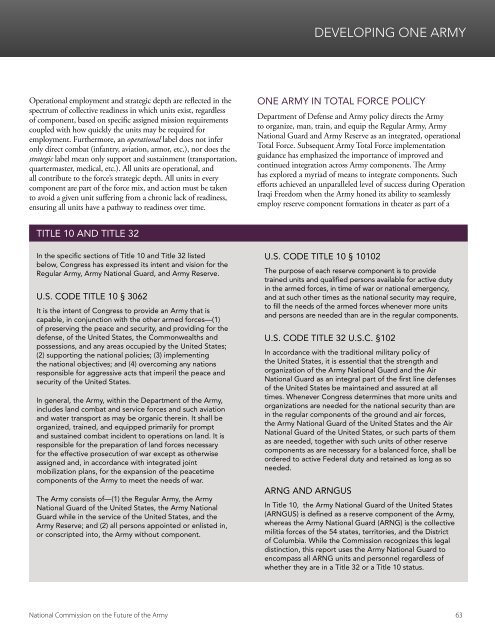THE FUTURE OF THE ARMY
Futurearmy
Futurearmy
You also want an ePaper? Increase the reach of your titles
YUMPU automatically turns print PDFs into web optimized ePapers that Google loves.
DEVELOPING ONE <strong>ARMY</strong><br />
Operational employment and strategic depth are reflected in the<br />
spectrum of collective readiness in which units exist, regardless<br />
of component, based on specific assigned mission requirements<br />
coupled with how quickly the units may be required for<br />
employment. Furthermore, an operational label does not infer<br />
only direct combat (infantry, aviation, armor, etc.), nor does the<br />
strategic label mean only support and sustainment (transportation,<br />
quartermaster, medical, etc.). All units are operational, and<br />
all contribute to the force’s strategic depth. All units in every<br />
component are part of the force mix, and action must be taken<br />
to avoid a given unit suffering from a chronic lack of readiness,<br />
ensuring all units have a pathway to readiness over time.<br />
ONE <strong>ARMY</strong> IN TOTAL FORCE POLICY<br />
Department of Defense and Army policy directs the Army<br />
to organize, man, train, and equip the Regular Army, Army<br />
National Guard and Army Reserve as an integrated, operational<br />
Total Force. Subsequent Army Total Force implementation<br />
guidance has emphasized the importance of improved and<br />
continued integration across Army components. The Army<br />
has explored a myriad of means to integrate components. Such<br />
efforts achieved an unparalleled level of success during Operation<br />
Iraqi Freedom when the Army honed its ability to seamlessly<br />
employ reserve component formations in theater as part of a<br />
TITLE 10 AND TITLE 32<br />
In the specific sections of Title 10 and Title 32 listed<br />
below, Congress has expressed its intent and vision for the<br />
Regular Army, Army National Guard, and Army Reserve.<br />
U.S. CODE TITLE 10 § 3062<br />
It is the intent of Congress to provide an Army that is<br />
capable, in conjunction with the other armed forces—(1)<br />
of preserving the peace and security, and providing for the<br />
defense, of the United States, the Commonwealths and<br />
possessions, and any areas occupied by the United States;<br />
(2) supporting the national policies; (3) implementing<br />
the national objectives; and (4) overcoming any nations<br />
responsible for aggressive acts that imperil the peace and<br />
security of the United States.<br />
In general, the Army, within the Department of the Army,<br />
includes land combat and service forces and such aviation<br />
and water transport as may be organic therein. It shall be<br />
organized, trained, and equipped primarily for prompt<br />
and sustained combat incident to operations on land. It is<br />
responsible for the preparation of land forces necessary<br />
for the effective prosecution of war except as otherwise<br />
assigned and, in accordance with integrated joint<br />
mobilization plans, for the expansion of the peacetime<br />
components of the Army to meet the needs of war.<br />
The Army consists of—(1) the Regular Army, the Army<br />
National Guard of the United States, the Army National<br />
Guard while in the service of the United States, and the<br />
Army Reserve; and (2) all persons appointed or enlisted in,<br />
or conscripted into, the Army without component.<br />
U.S. CODE TITLE 10 § 10102<br />
The purpose of each reserve component is to provide<br />
trained units and qualified persons available for active duty<br />
in the armed forces, in time of war or national emergency,<br />
and at such other times as the national security may require,<br />
to fill the needs of the armed forces whenever more units<br />
and persons are needed than are in the regular components.<br />
U.S. CODE TITLE 32 U.S.C. §102<br />
In accordance with the traditional military policy of<br />
the United States, it is essential that the strength and<br />
organization of the Army National Guard and the Air<br />
National Guard as an integral part of the first line defenses<br />
of the United States be maintained and assured at all<br />
times. Whenever Congress determines that more units and<br />
organizations are needed for the national security than are<br />
in the regular components of the ground and air forces,<br />
the Army National Guard of the United States and the Air<br />
National Guard of the United States, or such parts of them<br />
as are needed, together with such units of other reserve<br />
components as are necessary for a balanced force, shall be<br />
ordered to active Federal duty and retained as long as so<br />
needed.<br />
ARNG AND ARNGUS<br />
In Title 10, the Army National Guard of the United States<br />
(ARNGUS) is defined as a reserve component of the Army,<br />
whereas the Army National Guard (ARNG) is the collective<br />
militia forces of the 54 states, territories, and the District<br />
of Columbia. While the Commission recognizes this legal<br />
distinction, this report uses the Army National Guard to<br />
encompass all ARNG units and personnel regardless of<br />
whether they are in a Title 32 or a Title 10 status.<br />
National Commission on the Future of the Army 63


